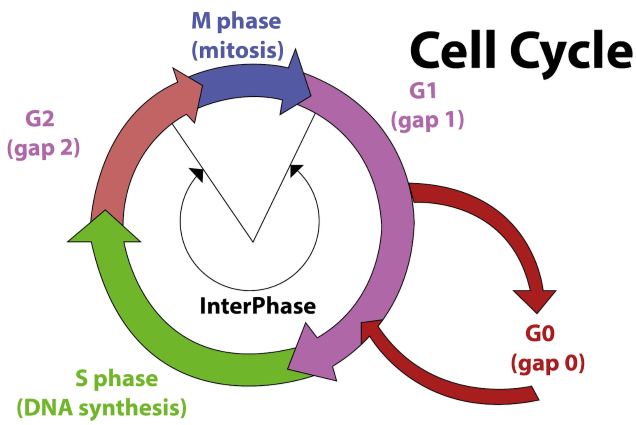
Which phase comes in between the
(a)M phase
(b)
(c)S phase
(d)Interphase
Answer
475.2k+ views
Hint This is the phase of the cell cycle in which DNA replication takes place. It is also called a synthesis phase. In this stage, the genetic material of a cell is doubled before it enters mitosis or meiosis, allowing there to be enough DNA to be split into daughter cells.
Complete answer:
New cells are formed from pre-existing cells. The cell cycle includes a sequence of events that helps in cell duplication where DNA synthesis takes place during one particular stage in the cell cycle. The interphase of the cell cycle comprises
Additional information:
The four stages of the cell cycle are as follows:
S phase – ( also known as synthesis phase) is the period during which DNA synthesis and DNA replication take place. The amount of DNA per cell doubles but there is no increase in chromosome number.
In animal cells during the S phase DNA replication begins in the nucleus and centriole duplicates in the cytoplasm.
M phase(mitotic phase) – Cell growth and protein production stop at this stage in the cell cycle. This stage consists of nuclear division (karyokinesis) followed by cytoplasmic division (cytokinesis). Mitosis stage is shorter than interphase in terms of time taken, lasting perhaps only one to two hours.

So, the correct answer is ‘ S phase’.
Note:
-During the
-The interphase lasts for more than 95% of the duration of the cell cycle.
Complete answer:
New cells are formed from pre-existing cells. The cell cycle includes a sequence of events that helps in cell duplication where DNA synthesis takes place during one particular stage in the cell cycle. The interphase of the cell cycle comprises
Additional information:
The four stages of the cell cycle are as follows:
S phase – ( also known as synthesis phase) is the period during which DNA synthesis and DNA replication take place. The amount of DNA per cell doubles but there is no increase in chromosome number.
In animal cells during the S phase DNA replication begins in the nucleus and centriole duplicates in the cytoplasm.
M phase(mitotic phase) – Cell growth and protein production stop at this stage in the cell cycle. This stage consists of nuclear division (karyokinesis) followed by cytoplasmic division (cytokinesis). Mitosis stage is shorter than interphase in terms of time taken, lasting perhaps only one to two hours.

So, the correct answer is ‘ S phase’.
Note:
-During the
-The interphase lasts for more than 95% of the duration of the cell cycle.
Recently Updated Pages
Express the following as a fraction and simplify a class 7 maths CBSE

The length and width of a rectangle are in ratio of class 7 maths CBSE

The ratio of the income to the expenditure of a family class 7 maths CBSE

How do you write 025 million in scientific notatio class 7 maths CBSE

How do you convert 295 meters per second to kilometers class 7 maths CBSE

Write the following in Roman numerals 25819 class 7 maths CBSE

Trending doubts
State and prove Bernoullis theorem class 11 physics CBSE

What are Quantum numbers Explain the quantum number class 11 chemistry CBSE

Write the differences between monocot plants and dicot class 11 biology CBSE

1 ton equals to A 100 kg B 1000 kg C 10 kg D 10000 class 11 physics CBSE

State the laws of reflection of light

One Metric ton is equal to kg A 10000 B 1000 C 100 class 11 physics CBSE




